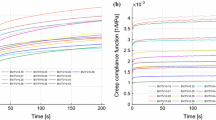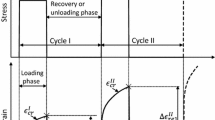Abstract
To explore the hypothesis that mechanical excitation-induced fluid flow and/or fluid pressure are potential mechanical transduction mechanisms in bone adaptation, a complementary experimental and analytical modeling effort has been undertaken. Experimentally, viscoelastic tanδ properties of saturated cortical bovine bone were measured in both torsion and bending, and significant tan δ values in the 100-105Hz range were observed, although the nature of the damping is not consistent with a fluid pressure hypothesis. Analytically, micromechanically based poroelasticity models were exercised to quantify energy dissipation associated with load-induced fluid flow in large scale channels. The modeling results indicate that significant damping due to fluid flow occurs only above 1 MHz frequencies. Together, the experimental and analytical results indicate that at excitation frequencies presumed to be physiological (1–100 Hz), mechanical loading of bone generates extremely small pore fluid pressures, making the hypothesized fluid-pressure transduction mechanism upon osteocytes untenable. © 2001 Biomedical Engineering Society.
PAC01: 8380Lz, 8710+e, 8385Cg
Similar content being viewed by others
References
Bassett, C. A. L., and R. O. Becker. Generation of electric potentials in bone in response to mechanical stress. Science137:1063–1064, 1962.
Biot, M. A.General theory of three-dimensional consolidation. J. Appl. Phys.12:155–164, 1941.
Cowin, S. C.Bone stress adaptation models. J. Biomech. Eng.115:528–533, 1993.
Cowin, S. C.Bone poroelasticity. J. Biomech.323:217–38, 1999.
Cowin, S. C., and D. H. Hegedus. Bone remodeling. I. Theory of adaptive elasticity. J. Elast.6:331–326, 1976.
Currey, J. The Mechanical Adaptations of Bones, Princeton: Princeton University Press, 1984
Frost, J. Mathematical Elements of Lamellar Bone Remodelling, Springfield, IL: Charles C. Thomas, 1964.
Fukada, E., and I. Yasuda. On the piezoelectric effect of bone. J. Phys. Soc. Jpn.10:1158–1169, 1957.
Garner, E. B., R. S. Lakes, T. Lee, C. Swan, and R. A. Brand. Viscoelastic dissipation in compact bone: Implications for stress-induced fluid flow in bone. J. Biomech. Eng.122:166–172, 2000.
Goodship, A. E., L. E. Lanyon, and H. McFie. Functional adaptation of bone to increased stress. J. Bone Jt. Surg.61–A, 4:539–546, 1979.
Jacobs, C. R., C. E. Yellowley, B. R. Davis, Z. Zhou, J. M. Cimbala, and H. J. Donahue. Differential effect of steady versus oscillating flow on bone cells. J. Biomech.31:969–976, 1998.
Jendrucko, R. J., W. A. Hyman, P. H. Newell, and B. K. Chakrabarty. Theoretical evidence for the generation of high pressure in bone cells. J. Biomech.9:87–91, 1976.
Johnson, M. W., D. A. Chakkalakal, R. A. Harper, J. L. Katz, and S. W. Rouhana. Fluid flow in bone in vitro. J. Biomech.15:881–885, 1982.
Lakes, R. S., and J. L. Katz. Viscoelastic properties of wet cortical bone. II. Relaxation mechanisms. J. Biomech.12:679–687, 1979.
Lakes, R. S., and S. Saha. Cement line motion in bone. Science204:501–503, 1979.
Lakes, R. S., H. S. Yoon, and J. L. Katz. Ultrasonic wave propagation and attenuation in wet bone. J. Biomed. Eng.8:143–148, 1986.
Lakes, R. S., and J. Quackenbush. Viscoelastic behavior in indium tin alloys over a wide range of frequency and time. Philos. Mag. Lett.74:227–238, 1996.
Lakes, R. S., Viscoelastic Properties of Cortical Bone. In Bone Mechanics Handbook, 2nd ed., edited by S. C. Cowin. Boca Raton, FL: CRC Press, 2000.
Lanyon, L. E.Functional strain as a determinant for bone remodeling. Calcif. Tissue Int.36:S56–S61, 1984.
Levy, C., M. Perl, and K. R. Gordon. Geometrical, mechanical, and structural adaptation of mouse femora exposed to different loadings. J. Eng. Mech.124:217–222, 1998.
Lugassy, A. A., and E. Korostoff. Viscoelastic behavior of bovine femoral cortical bone and sperm whale dentin. In Research in Dental and Medical Materials, New York: Plenum, 1969.
Otter, T., and E. D. Salman. Hydrostatic pressure reversibly blocks membrane control of ciliary motion in paramecium. Science206:358–361, 1979.
Piekarski, K., and M. Munro. Transport mechanism operating between blood supply and osteocytes in long bones. Nature (London)269:80–82, 1977.
Pollack, S. R., N. Petrov, R. Salzstein, G. Brankov, and R. Blagoeva. An anatomical model for streaming potentials in osteons. J. Biomech.17:627–636, 1984.
Roelofsen, J., J. Klein-Nulend, and E. H. Burger. Mechanical stimulation by intermittent hydrostatic compression promotes bone-specific gene expression in vitro. J. Biomech.28:1493–1503, 1995.
Rouhana, S. W., M. W. Johnson, D. A. Chakkalakal, R. A. Harper, and J. L. Katz. Permeability of compact bone Joint ASME-ASCE Conference of the Biomechanics Symposium. AMD (Am. Soc. Mech. Eng.)43:169–172, 1981.
Rubin, C. T., and L. E. Lanyon. Regulation of bone mass by mechanical strain magnitude. Calcif. Tissue Int.37:411–417, 1985.
Sasaki, N., Y. Nakayama, M. Yoshikawa, and A. Enyo. Stress relaxation function of bone and bone collagen. J. Biomech.26:1369–1376, 1993.
Scheidegger, A. E. The Physics of Flow through Porous Media. New York: Macmillan, 1957.
Swan, C. C.Techniques for stress and strain controlled homogenization of inelastic periodic composites. Comput. Methods Appl. Mech. Eng.117:249–267, 1994.
Wolff, J. Das Gesetz der Transformation der Knochen. Berlin: A. Hirschwald, 1892.
Zhang, D., S. Weinbaum, and S. C. Cowin. Estimates of the peak pressures in bone pore water. J. Biomech. Eng.120:697–703, 1998.
Author information
Authors and Affiliations
Rights and permissions
About this article
Cite this article
Buechner, P.M., Lakes, R.S., Swan, C. et al. A Broadband Viscoelastic Spectroscopic Study of Bovine Bone: Implications for Fluid Flow. Annals of Biomedical Engineering 29, 719–728 (2001). https://doi.org/10.1114/1.1385813
Issue Date:
DOI: https://doi.org/10.1114/1.1385813




